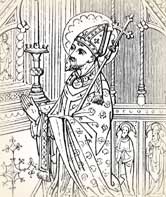 Edmund of Abingdon, Archbishop of Canterbury, had a motto: "Caclum
dives ingredi." It meant "to enter heaven rich." It was a pun on his
family name, for the merchant's son was named Edmund Rich.
Edmund of Abingdon, Archbishop of Canterbury, had a motto: "Caclum
dives ingredi." It meant "to enter heaven rich." It was a pun on his
family name, for the merchant's son was named Edmund Rich.Edmund's parents were deeply religious folk after the fashion of the time, imposing daily penances on themselves. Their interest in spiritual matters spilled over onto Edmund. As a youth, studying at newly formed Oxford University, he believed he had literally encountered Jesus while he was walking alone in a field one evening. Ever afterward, this gentle man made a special gesture of remembrance each night before he went to bed. He vowed to remain chaste.
Edmund learned well and became a doctor of divinity. Soon he became a teacher, lecturing at the universities of Oxford and of Paris. He was the first, in fact, to teach the works of Aristotle at his Alma Mater. On both sides of the channel he was held in high esteem for his holiness. At night, he spent more time in prayer than in sleep. His preaching was so dynamic that he was commissioned to preach the sixth crusade.
On this day, April 2, 1234, Edmund was consecrated Archbishop of Canterbury. The position brought him much conflict with King Henry III of England. Henry was a corrupt man, who refused to allow Edmund to fill church vacancies. Meanwhile, the king pocketed the church revenues. Despite the king's opposition, Edmund struggled hard to clean up the church and restore its rights. In 1236 he issued a series of "constitutions," but the corrupt churchmen of the realm refused to be reigned in. (Some of his rules were still in force in the twentieth century.) He also worked with a coalition of barons to try to suppress the power of Henry's foreign-born favorites.
Edmund wrote to Pope Gregory IX for help over the issue of the vacancies, but Gregory failed to resolve the situation. In fact, the papal legate himself fell under Henry's power and the vacancies continued to pile up.
Caught between a rock and a hard place, Edmund fled from England and retired to Pontigny, France. He died there in 1240. Edmund was so admired that his final resting place became a popular destination for pilgrims.
Bibliography:
- Baring-Gould, S. Lives of the Saints. Edinburgh: John Grant, 1914.
- Edmonds, Columba. "St. Edmund Rich." The Catholic Encyclopedia. New York: Robert Appleton, 1914.
- "Edmund, St., of Abingdon." The Oxford Dictionary of the Christian Church. Edited by F. L. Cross and E. A. Livingstone. Oxford, 1997.
- Hook, Walter Farquhar, 1798 - 1875. Lives of the Archbishops of Canterbury. London, R. Bentley, 1865 - 1884.
- McKilliam, Annie E. A Chronicle of the Archbishops of Canterbury. London: J. Clarke, 1913.
- Waite, Joseph F. "Saint Edmund of Canterbury 1170-1240 Patron of the Society of St. Edmund." http://www.sse.org/pdf/StEdmundHistoryWaite4Pg.pdf
- Various encyclopedia and internet articles.